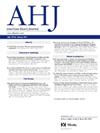无标准可改变危险因素的急性心肌梗死患者的健康状况结局
IF 3.7
2区 医学
Q1 CARDIAC & CARDIOVASCULAR SYSTEMS
引用次数: 0
摘要
背景:先前对没有标准可变危险因素(smurf)(如糖尿病、血脂异常、高血压和吸烟)的急性心肌梗死(AMI)患者的研究报告显示,与有smurf的患者相比,AMI患者住院率更高,但长期死亡率更低。然而,smurf对首次AMI后健康状况结果(患者症状、功能和生活质量)的影响尚不清楚。方法:来自两个前瞻性登记中心(PREMIER和TRIUMPH)的数据被用于识别2003-2008年间在31家美国医院因AMI住院的无冠状动脉疾病病史的患者。使用西雅图心绞痛问卷(SAQ)总结评分收集12个月的连续健康状况。采用分层线性混合模型对基线SAQ评分、临床和社会人口学特征进行顺序调整,比较有和没有smurf的患者在12个月内SAQ的变化。结果:4076例首次AMI患者(平均年龄58.4±12.4岁,女性34%,黑人22%)中,569例(14.0%)未出现smurf。与有smurf的患者相比,无smurf的患者多为男性、白人、较高的收入和受教育程度、较少的抑郁症状和较高的基线SAQ总结评分(83.5±13.2比79.6±16.5)。在调整基线SAQ评分后,无smurf的患者在12个月时SAQ总结评分的改善大于有smurf的患者(组间调整差异 = 2.61分,95%CI: 1.29-3.93),但临床和社会经济特征的顺序调整减弱了这种差异(1.69分,95%CI 0.40-1.97)。结论:在AMI患者中,无可改变危险因素的患者与有可改变心血管危险因素的患者在12个月时的健康状况相似,这应该为二级预防目标较少的患者提供保证。本文章由计算机程序翻译,如有差异,请以英文原文为准。
Health status outcomes after acute myocardial infarction in patients without standard modifiable risk factors
Background
Prior studies of patients presenting with acute myocardial infarction (AMI) without Standard Modifiable Risk Factors (SMuRFs), such as diabetes, dyslipidemia, hypertension, and smoking, reported higher in-hospital but lower long-term mortality than those with SMuRFs. However, the impact of SMuRFs on health status outcomes (patients’ symptoms, function, and quality of life) after a first AMI are unknown.
Methods
Data from 2 prospective registries, PREMIER and TRIUMPH, were used to identify patients with no prior history of coronary disease hospitalized at 31 U.S. hospitals for AMI between 2003 and 2008. Serial health status over 12 months was collected using the Seattle Angina Questionnaire (SAQ) Summary Score. Changes in SAQ over 12 months were compared between patients with and without SMuRFs using hierarchical linear mixed models with sequential adjustments for baseline SAQ scores, clinical, and sociodemographic characteristics.
Results
Among 4076 patients with a first AMI (mean age 58.4 ± 12.4, 34% female, 22% Black), 569 (14.0%) presented without SMuRFs. Compared with patients with SMuRFs, those without SMuRFs were more likely to be male, White, have higher income and education, fewer depressive symptoms, and higher baseline SAQ Summary Scores (83.5 ± 13.2 vs. 79.6 ± 16.5). After adjusting for baseline SAQ scores, patients without SMuRFs had larger SAQ Summary Score improvements at 12 months than those with SMuRFs (adjusted difference between groups = 2.61 points, 95% CI: 1.29-3.93), but sequential adjustment for clinical and socioeconomic characteristics attenuated this difference (1.69 points, 95% CI 0.40-1.97).
Conclusions
Among AMI patients, those without modifiable risk factors had similar health status at 12-months as compared with those having modifiable cardiovascular risk factors, which should provide reassurance to those with less targets for secondary prevention.
求助全文
通过发布文献求助,成功后即可免费获取论文全文。
去求助
来源期刊

American heart journal
医学-心血管系统
CiteScore
8.20
自引率
2.10%
发文量
214
审稿时长
38 days
期刊介绍:
The American Heart Journal will consider for publication suitable articles on topics pertaining to the broad discipline of cardiovascular disease. Our goal is to provide the reader primary investigation, scholarly review, and opinion concerning the practice of cardiovascular medicine. We especially encourage submission of 3 types of reports that are not frequently seen in cardiovascular journals: negative clinical studies, reports on study designs, and studies involving the organization of medical care. The Journal does not accept individual case reports or original articles involving bench laboratory or animal research.
 求助内容:
求助内容: 应助结果提醒方式:
应助结果提醒方式:


